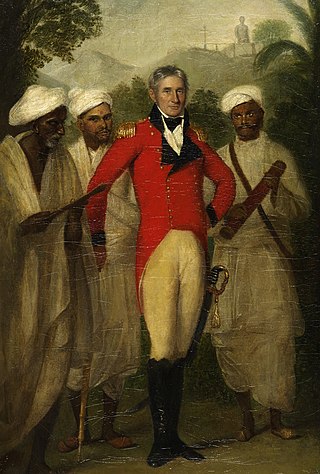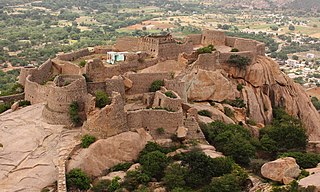Kamma is a Hindu caste from South India. The community of Kammas is believed to have originated from agriculturists of the Kammanadu region of the Guntur and Prakasam districts in Andhra Pradesh. Propelled by their military activity in the Vijayanagara Empire, Kammas are believed to have spread out from the region during the Vijayanagara period, followed by some in-migration during the British period and out-migration again during the twentieth century. Today they are regarded as the richest group in Andhra Pradesh and are a dominant caste from Coastal Andhra with socio-economic and political prominence throughout the Telugu-speaking regions of India.

Deccani or Dakni, Dakhni, Dakhini, Dakkhani and Dakkani, is a variety of Hindustani spoken in the Deccan region of India and the native language of the Deccani people. Commonly associated with Urdu, the historical dialect sparked the development of Urdu literature during the late-Mughal period, and was a predecessor to and later influenced modern standard Hindi. It arose as a lingua franca under the Delhi and Bahmani Sultanates, as trade and migration from the north introduced Hindustani to Southern India. It later developed a literary tradition under the patronage of the Deccan Sultanates. In the modern era, it has survived only as a spoken lect. Deccani differs from Hindustani due to archaisms retained from the medieval era, as well as convergence with regional languages like Marathi, Telugu and Kannada spoken in the states of Maharashtra, Telangana, Andhra Pradesh and Karnataka. In recent times, Deccani has been increasingly influenced by Standard Urdu, which serves as its formal register.

The Vijayanagara Empire coverered much of the region of South India, controlling the lands of the modern states of Karnataka, Andhra Pradesh, Tamil Nadu, Kerala, Goa and some parts of Telangana and Maharashtra. It was established in 1336 by the brothers Harihara I and Bukka Raya I of the Sangama dynasty, members of a pastoralist cowherd community that claimed Yadava lineage. The empire rose to prominence as a culmination of attempts by the southern powers to ward off Perso-Turkic Islamic invasions by the end of the 13th century. At its peak, it subjugated almost all of South India's ruling families and pushed the sultans of the Deccan beyond the Tungabhadra-Krishna river doab region, in addition to annexing Gajapati Kingdom (Odisha) till Krishna river, thus becoming a notable power. It lasted until 1646, although its power declined after a major military defeat in the Battle of Talikota in 1565 by the combined armies of the Deccan sultanates. The empire is named after its capital city of Vijayanagara, whose ruins surround present day Hampi, now a World Heritage Site in Karnataka, India. The wealth and fame of the empire inspired visits by and writings of medieval European travelers such as Domingo Paes, Fernão Nunes, and Niccolò de' Conti. These travelogues, contemporary literature and epigraphy in the local languages, and modern archeological excavations at Vijayanagara have provided ample information about the history and power of the empire.

Colonel Colin Mackenzie CB was Scottish army officer in the British East India Company who later became the first Surveyor General of India. He was a collector of antiquities and an orientalist. He surveyed southern India, making use of local interpreters and scholars to study religion, oral histories, inscriptions and other evidence, initially out of personal interest, and later as a surveyor. He was ordered to survey the Mysore region shortly after the British victory over Tipu Sultan in 1799 and produced the first maps of the region along with illustrations of the landscape and notes on archaeological landmarks. His collections consisting of thousands of manuscripts, inscriptions, translations, coins and paintings, which were acquired after his death by the India Office Library and are an important source for the study of Indian history. He was awarded a Companion of the Order of the Bath on 4 June 1815.

The Qutb Shahi dynasty was a Persianate Shia Islamic dynasty of Turkoman origin that ruled the Sultanate of Golkonda in southern India. After the collapse of Bahmani Sultanate, the Qutb Shahi dynasty was established in 1512 AD by Sultan-Quli Qutb-ul-Mulk, better known though less correctly referred to in English as "Quli Qutb Shah".

The Satavahanas, also referred to as the Andhras in the Puranas, were an ancient Indian dynasty based in the Deccan region. Most modern scholars believe that the Satavahana rule began in the late second century BCE and lasted until the early third century CE, although some assign the beginning of their rule to as early as the 3rd century BCE based on the Puranas, but uncorroborated by archaeological evidence. The Satavahana kingdom mainly comprised the present-day Andhra Pradesh, Telangana, and Maharashtra. At different times, their rule extended to parts of modern Gujarat, Madhya Pradesh, and Karnataka. The dynasty had different capital cities at different times, including Pratishthana (Paithan) and Amaravati (Dharanikota).

The Kakatiya dynasty was a Telugu dynasty that ruled most of eastern Deccan region in present-day India between 12th and 14th centuries. Their territory comprised much of the present day Telangana and Andhra Pradesh, and parts of eastern Karnataka, northern Tamil Nadu, and southern Odisha. Their capital was Orugallu, now known as Warangal.

The Prithviraj Raso is a Braj language epic poem about the life of Prithviraj Chauhan. It is attributed to Chand Bardai, who according to the text, was a court poet of the king.

Madugula is a village in Anakapalli district in the state of Andhra Pradesh in India. It was also known as Vaddadi or Vaddadimadugula and was founded by the rulers of the Matsya dynasty. Later, it merged into the kingdom of Nandapur - Jeypore and during the British Raj it remained an independent Zamindari for sometime. Later, in 1915 the zamindaris of Madugula and Pachipenta were purchased by Maharaja Vikram Dev III and they became a part of Jeypore Samasthanam and were governed by the Maharaja of Jeypore until 1947.

The recorded history of Andhra Pradesh, one of the 28 states of 21st-century India, begins in the Vedic period. It is mentioned in Sanskrit epics such as the Aitareya Brahmana. Its sixth-century BCE incarnation Assaka lay between the Godavari and Krishna Rivers, one of sixteen mahajanapadas. The Satavahanas succeeded them, built Amaravati, and reached a zenith under Gautamiputra Satakarni.
Madakasira is a town with a population 19,432 in 2001 and also a mandal in Sri Satya Sai district in the state of Andhra Pradesh in India. It is located near the state border with Karnataka. The Madakasira Hill Fort in the town is a centrally protected monument of national importance.
Pancha Gauda is one of the two major groupings of Brahmins in Hinduism, of which the other is Pancha-Dravida.
Pancha Dravida is one of the two major groupings of Brahmins in Hinduism, of which the other was Pancha-Gauda.
Nandināgarī is a Brahmic script derived from the Nāgarī script which appeared in the 7th century AD. This script and its variants were used in the central Deccan region and south India, and an abundance of Sanskrit manuscripts in Nandināgarī have been discovered but remain untransliterated. Some of the discovered manuscripts of Madhvacharya of the Dvaita Vedanta school of Hinduism are in Nandināgarī script.

The Komati is a trading community found primarily in southern and central India, that is currently organised as a caste. The members of the Komati caste are commonly engaged in business pursuits. The community consists of many sects who are followers of Hinduism, namely the Gomata, the Thrivarnika (Trivarṇika) and the Kalinga (Kaliṅga), along with the Jaina Komatis who are followers of Jainism. Traditionally, most Komatis are vegetarian due to their belief in ahimsa (nonviolence).
Karanam, is a title and surname native to the Indian states of Andhra Pradesh and Telangana. Traditionally, Karanam or Karnam was a title used by people who maintained the accounts and records of the villages and used in collecting taxes. The post was usually held by either Niyogi Brahmins or Karan Kayastha or Deshastha Brahmins. The title Karanam is similar to Kulkarni in North Karnataka and Maharashtra and Shanbhaug in Karnataka.
Therazhundur Venkataraman Mahalingam was an Indian historian who is known for publishing the most authoritative descriptive catalogues on the Mackenzie manuscripts.
Rajamundry Sarkar was one of the five Northern Circars in the Golconda Sultanate, Deccan Subah of Mughal empire and later in the Nizam's dominion of Hyderabad. During Qutb Shahi, Mughal and Nizam rule it was referred in official records with name Rājmandrī and the same name was anglicized in the British colonial era as Rajahmundry or Rajamundry. The Northern Circars were the most prominent ones in the Subah of Deccan. The Northern Circars were five in number: Chicacole (Srikakulam), Rajmandri (Rajahmundry), Ellore (Eluru), Mustaphanagar (Kondapalli) and Murtuzanagar (Guntur). A Circar was an English spelling of sarkar, a Mughal term for a district (a subdivision of a subah or province), which had been in use since the time of Sher Shah Suri (1486–1545). A sarkar was further divided into Mahals or Parganas. The Hills in the Eastern Ghats near Pentakota village were considered the northern limit of the Rajahmundry Circar beyond which was the Chicacole Circar. The southern limit was bounded by Ellor circar with the Godavari river demarcating the boundary.

Madakasira Fort, also known as Simhagiri, is a hill fort located in the Madakasira town of Sri Sathya Sai district, in Andhra Pradesh, India. The Government of India has designated it as a Monument of National Importance.

Chowdhary Satyanarayana Patnaik, commonly known as C. S. N. Patnaik, was an Indian sculptor and painter from the state of Andhra Pradesh. He specialized in fresco and mural painting and bronze sculpting. His paintings incorporated depictions of rural life and its tradition and culture. He sculpted a statue of Mahatma Gandhi which was installed at the Telangana Legislative Assembly. He received the Kala Ratna award in 2006.













